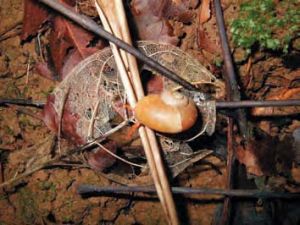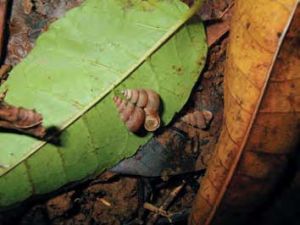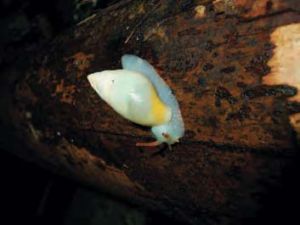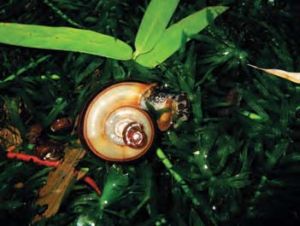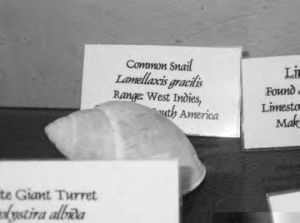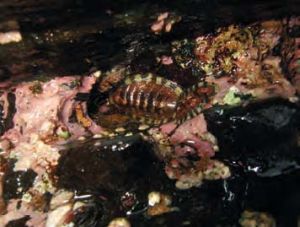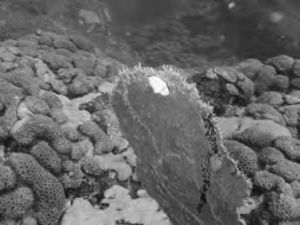|
Last year I was invited by a friend from my university days to join an expedition to Trinidad. Our main purpose was collecting tree frogs for investigation into toe-pad adhesion along with other behavioural studies. I was mainly employed as a driver, frog-catcher and responsible adult to help with the undergraduate students. In my spare time I endeavoured to do a bit of collecting for Glasgow Museums, where I am the curator of invertebrates. The expedition ran from June to August and using a combination of annual leave along with some research leave I was able to go for five weeks. The team was based in The William Beebe Tropical Research Station, also known as Simla, which is located in the Arima valley in northern Trinidad. From the tropical rainforest around our accommodation we collected some of the frogs we needed, but we also went to sites all over Trinidad to get the species we were after. From around Simla I collected a few empty shells from the forest floor but also came across some living examples as well. Although the shells were quite dull the animals inside were often brightly coloured and I was quite happy to take only pictures and be content with my already dead specimens. As far as I can work out I found several Translucent Cyclotus - Neocyclotus translucidus trinitensis (Fig.1), a species of Annularid (Fig.2) and a species of Drymaeus (Fig.3). I have been unable to identify the last two specimens down to species level. Another interesting find, in some abandoned concrete ponds near to the house, were hundreds of Marisa cornuarietis (Fig.4). At first glance I thought they were Planorbids but the presence of an operculum made me look again. As well as the live ones in the pond there were many dead shells scattered around nearby possibly indicating that some animal was finding them to be a good source of food. The capital of Trinidad is Port of Spain; a sprawling city situated in the north west of the country. There is a fair sized zoo with a good representation of the islands vertebrate wildlife. The enclosures are of a mixed standard with some animals having large landscaped habitats but with others stuck in small old-fashioned cages. The only invertebrate I came across was a megasnail shell amongst a small collection of dead objects but unfortunately it had been mislabelled as a Lamellaxis gracilis (Fig.5). One highlight of my trip was a boat tour of the Caroni Swamp, just south of Port of Spain. It is a world famous destination for bird watchers eager to see flocks of scarlet ibis but there are many other interesting plants and animals to be seen as well. Cook’s tree boas coiled up in the trees and caimans lying on the mudflats were just some of the denizens of the huge mangrove swamp. On many of the thick mangrove roots there were Caribbean edible oysters (Crassostrea rhizophorae) although they were apparently getting harder to find as they are being over-harvested. A couple of the best beaches on the island, as far as people are concerned, are La Paz and Las Cuevas along the northern coast. Some of the areas where we collected frogs were nearby so we often had time for swimming, sunbathing and also a bit of beachcombing. La Paz beach is very long and sandy but there are rocks at the western end where I found several common West Indian chitons - Chiton tuberculatas (Fig.6). On rocks at the eastern end of Las Cuevas beach I found many specimens of chequered nerites - Nerita tessellata and wide-mouthed purpura - Purpura patula clinging on to exposed rocks at low tide. Although both are common shells throughout the region there was some value and interest in finding them. The nerite displays a large variety of patterning and the purpura is used as a source of purple dye much like Murex brandaris was used in Europe. I was lucky enough to get a break from the hard work in Trinidad and have a weekend on Tobago which is a much more tourist-orientated island and more like the tropical paradise of the popular imagination. As I was browsing through some of the stalls in Crown Point I saw a whole table covered in Queen conch shells - Strombus gigas (Fig.7). I soon got talking to the man who owned the stall and asked him where his specimens came from as I was working on a display at the museum about souvenirs that endanger wildlife. He told me that divers collect them and sell them on for a cheap price after eating the soft parts; he also said that the divers had to go deeper and search further afield for specimens. Although foreign tourists buy many there is also a demand for conch shells amongst the locals. During cricket matches, the sound of hundreds of conch shell trumpets rings out, often frightening the visitors but inspiring the home team. Whilst I was snorkelling in Pirate’s Bay off Charlotteville I saw many amazing animals but the two that stood out for me most were, not surprisingly, molluscs. The first was a flamingo tongue shell - Cyphoma gibbosum (Fig.8) crawling across a sea fan, it stuck out like a sore thumb but I only saw one example. The second was a small shoal of Caribbean reef squid - Sepioteuthis sepioidea, which came out of nowhere. They moved so gracefully and were so beautiful that I almost forgot to go up and breathe again and I was very reluctant to finally leave the water after having watched them for almost quarter of an hour. On a walk to Argyll waterfalls in Tobago I found a Megalobulimus oblonga albus or the white form of the oblong megasnail, it had been half buried in the earth and didn’t fancy coming out of it’s shell. Fortunately when I got back to Simla I found another M. oblonga (Fig.9) crawling along through the forest, I was amazed by the fringe around the mouth and watched it crawl around a table in the lab for quite a long time. The highest numbers of shells were found on my last day in Trinidad when we visited Tamana Caves. The caves are situated in a limestone outcrop in the middle of the island; the ground above is covered in a mix of secondary forest largely consisting of cocoa and citrus trees and remnants of primary rainforest. As we walked up the hill to the cave openings there were many empty shells scattered all over the ground, I collected maybe a dozen or so and later found out they were squirrel ear auris - Eudolichotis aurissciuri. The caves themselves were only accessible from one entrance that took you into a cavern filled with thousands of bats flying over your head and thousands of cockroaches at your feet. The smell was quite pungent to say the least but it was an amazing experience. A word of advice for any future visitors is wear a wide brimmed hat and don’t look up with your mouth open, the almost constant rain of urine and droppings from the bats is considerable. There were also a few shells that I didn’t know I had until I returned home. I had collected an oropendola’s nest whilst on our way to Tamana caves. It had fallen from a tree and been lying on the ground for at least a few weeks, I bagged it up and didn’t look at it again until I was back in Glasgow. Out of curiosity I had a look through the debris that had fallen to the bottom of the bag and was pleasantly surprised to find a whole host of invertebrates. As well as several species of mites and ants I found eight tiny shells. Some were broken or immature but there were two that I felt were worthy of further investigation. As far as I have been able to ascertain they are from the Gastrocopta genus (Fig.10) but I have been unable to identify them to species level. It may be a new species and I will be carrying out further investigation hopefully leading to an article for the Journal of Conchology. |
Fig 1
Fig 2
Fig 3
Fig 4
Fig 5
Fig 6
Fig 7
Fig 8
Fig 9
Fig 10 |
Molluscs in Trinidad and Tobago
Issue
8
Page
10

